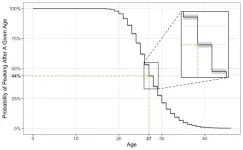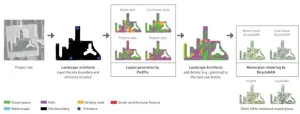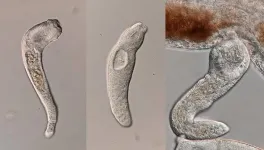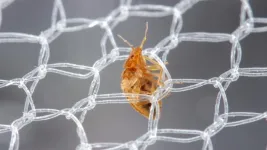How to eliminate racial disparities in colon cancer
2024-07-24
(Press-News.org)
A new paper in the Journal of the National Cancer Institute, published by Oxford University Press, finds that eliminating the race disparity in colon cancer testing in the United States would reduce colon cancer, and colon cancer death rates, dramatically among Black people.
Colorectal cancer rates and deaths from the disease have decreased over time, but racial disparities remain and are significant. Compared to White Americans, Black Americans experience higher rates of colorectal cancer incidence and lower survival rates. Black adults are approximately 23% more likely to receive a colorectal cancer diagnosis than White adults. They are also about 31% more likely to die from the disease.
Researchers have previously identified screening adherence as the main driver of racial disparities in colorectal cancer incidence and mortality. A 2005 study using data from National Health Interview Survey of adults over 50 showed that 52% of White people were up to date on colorectal cancer screenings but only 39% of Black people were up to date. The gap has narrowed in recent years and rates have improved overall. In 2019 69.5% of Black people and 69.8% of White people were keeping up with their screenings. Yet persistent Black-White disparities in colorectal cancer incidence, mortality, and survival remain.
The benefits of colorectal cancer screening programs rely on patients completing a follow-up colonoscopy if doctors first discover an abnormal result in the initial non-colonoscopy test patients over 50 get as part of their normal treatment. The quality of a colonoscopy screening is also particularly important. Existing data demonstrate significantly lower follow-up colonoscopy rates among Black patients. But even if Black-White disparities in the receipt of colonoscopy screening are small, disparities in outcomes can still be substantial; Black adults are more likely than White adults to receive a low-quality colonoscopy.
The researchers here investigated these other racial disparities between Black and White Americans related to colorectal cancer. Using previously established and validated mathematical cancer models as their analysis platform, the researchers simulated screening follow ups and colonoscopy quality rates in Black people to match those of White people to estimate how colorectal cancer outcomes could change with improvements in care and treatment.
They found that eliminating Black-White disparities in follow-up colonoscopy rates would reduce colorectal cancer incidence by 5.2%. Eliminating Black-White disparities in follow-up colonoscopy rates would reduce colorectal cancer mortality by 9.3%. They found that eliminating Black-White disparities in colonoscopy quality would reduce both colorectal cancer incidence and mortality by 9.4%. Eliminating differences in both follow-up rates and colonoscopy quality would reduce colorectal cancer incidence by 14.6% and colorectal cancer mortality by 18.7%.
Eliminating differences in both follow-up rates and colonoscopy quality would reduce the colorectal cancer incidence gap between Black and White people by 49%. Such changes would reduce the racial colorectal cancer mortality gap by 59%.
In this model the elimination of the Black-White disparities in colonoscopy quality and follow-up colonoscopy rates would still not improve outcomes among Black adults to those of White adults. The researchers believe this remaining gap is due to Black-White differences in general health and how patients receive treatment.
“People have long known that racial disparities in cancer exist,” said the paper’s lead author, Oguzhan Alagoz. “Usually, the focus has been on eliminating differences in adherence to screening, which reduces cancer deaths. However, our study shows that it's not enough to just get everyone screened; the quality of care during screening and follow-up must also be similar for Black and White adults. To truly close the racial gap in cancer deaths and achieve health equity, we need to find innovative solutions.”
The paper, “Impact of racial disparities in follow-up and quality of colonoscopy on colorectal cancer outcomes,” is available (at midnight on July 24th) at https://doi.org/10.1093/jnci/djae140.
Direct correspondence to:
Oguzhan Alagoz
Professor of Industrial and Systems Engineering
University of Wisconsin-Madison
1513 University Avenue, Madison, WI 53706
alagoz@engr.wisc.edu
To request a copy of the study, please contact:
Daniel Luzer
daniel.luzer@oup.com
END
ELSE PRESS RELEASES FROM THIS DATE:
2024-07-24
It's hard to know what Neanderthals ate: food preparation, especially when it comes to smaller items like birds, can leave few archaeological traces. But understanding their diets is critical to understanding these incredibly adaptable hominins, who thrived for hundreds of thousands of years in wildly varied environments. To learn what food preparation could look like in the archaeological record, scientists tried cooking like Neanderthals.
“Using a flint flake for butchering required significant precision and effort, which we had not fully valued before this experiment,” said Dr Mariana Nabais of the Institut ...
2024-07-24
WASHINGTON — A peer-reviewed study published today in the journal Environmental Health Perspectives has found that per- and polyfluoroalkyl substances (PFAS), known as “forever chemicals,” are increasingly being added to U.S. pesticide products, contaminating waterways and posing potential threats to human health.
The study, Forever Pesticides: A Growing Source of PFAS Contamination in the Environment, is the first-ever comprehensive review of the many ways PFAS are introduced into U.S. pesticide products. Pesticides containing PFAS are used throughout the country on staple ...
2024-07-24
There’s a lot that goes into an Olympic athlete’s quest for gold – years of training and rigour – but also, an athlete’s age. A team of University of Waterloo students used statistics to figure out when an Olympic track-and-field athletes’ peak performance will be.
Track-and-field encompasses running, jumping, throwing, and combined event disciplines. Most athletes’ career performance progressions can typically be visualized as a bell curve, in which they train over several years to reach their best performance, or “peak,” at a ...
2024-07-24
The shape of a person’s kneecap could be an indicator of whether they’re more at risk of developing osteoarthritis, according to a new study from The Australian National University (ANU).
According to lead author of the study, Associate Professor Laura Wilson, women who develop knee osteoarthritis often experience more severe symptoms than men, but the reason for this is not well understood. Osteoarthritis, the most common form of arthritis, is a debilitating joint disease that causes pain, stiffness and swelling.
The research team set out to investigate whether kneecap shape might be a contributing factor.
“We wanted to focus on ...
2024-07-24
In recent years, the rapid development and enhancement of image generation technologies and mapping tools driven by generative artificial intelligence (AI) have significantly impacted the traditional landscape design industry. Thus, it is pressing for landscape architects to delineate the relationship between image generation and landscape design and explore potential opportunities of practice and research. Research on masterplan generation primarily focuses on “image-to-image” generative adversarial network (GAN). The application of these tools has developed from the generation of architectural floor ...
2024-07-24
Insilico Medicine(“Insilico”), a clinical-stage generative artificial intelligence (AI)-driven drug discovery company, recently announces that the company has entered a strategic collaboration with Therasid Bioscience, an innovative biotechnology company founded in South Korea, to utilize advanced AI technology to co-develop novel therapies for the treatment of metabolic dysfunction associated steatohepatitis (MASH).
MASH, previously known as Non-alcoholic steatohepatitis (NASH), is a severe form of non-alcoholic fatty liver disease (NAFLD), characterized by liver inflammation and damage caused by a buildup of fat. Potentially progressing ...
2024-07-24
Research shows humans often perceive attractive people as more intelligent, healthier, better leaders and more trustworthy. It turns out this bias extends to the insect world.
A new study by scientists at the USC Dornsife College of Letters, Arts and Sciences reveals that data reported on a popular community science platform is biased. On iNaturalist, butterflies with captivating markings, easily identifiable features or those that are familiar species are reported more frequently than obscure species with no distinct qualities.
Why it matters: Online ...
2024-07-24
When people think of a concussion or a traumatic brain injury caused by intimate partner violence (IPV), they might picture people in a heterosexual relationship, or a man hurting a woman.
But a UBC Okanagan researcher points out that IPV, and its repercussions, is an issue in all relationships. Doctoral student Tori Stranges recently published a paper examining the prevalence and damage done by violence in Two-Spirit, Lesbian, Gay, Bisexual, Trans, Queer (or Questioning), Intersex and Asexual (2SLGBTQIA+) relationships.
“It’s very common for people to think that violence doesn’t ...
2024-07-24
New research from scientists at UC San Diego’s Scripps Institution of Oceanography finds a tiny freshwater parasite known to cause health problems in humans defends its colonies with a class of soldiers that cannot reproduce.
The discovery, published today in the Proceedings of the National Academy of Sciences and funded by the National Institutes of Health, vaults this species of parasitic flatworm into the ranks of complex animal societies such as ants, bees and termites, which also have distinct classes of workers and soldiers that have given up reproduction to serve their colony.
When it gets into humans, usually via the consumption of raw or undercooked fish, this species ...
2024-07-24
For decades, insecticide-treated bed nets and indoor insecticide spraying regimens have been important – and widely successful – treatments against mosquitoes that transmit malaria, a dangerous global disease. Yet these treatments also – for a time – suppressed undesirable household insects like bed bugs, cockroaches and flies.
Now, a new North Carolina State University study reviewing the academic literature on indoor pest control shows that as the household insects developed resistance ...
LAST 30 PRESS RELEASES:
[Press-News.org] How to eliminate racial disparities in colon cancer





